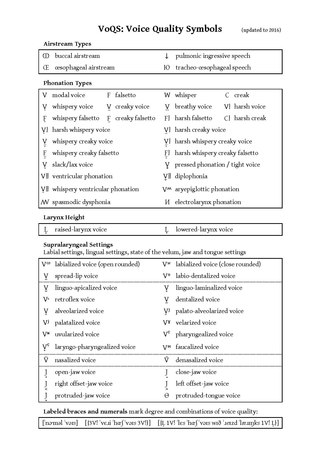Related Research Articles
Approximants are speech sounds that involve the articulators approaching each other but not narrowly enough nor with enough articulatory precision to create turbulent airflow. Therefore, approximants fall between fricatives, which do produce a turbulent airstream, and vowels, which produce no turbulence. This class is composed of sounds like and semivowels like and, as well as lateral approximants like.
A fricative is a consonant produced by forcing air through a narrow channel made by placing two articulators close together. These may be the lower lip against the upper teeth, in the case of ; the back of the tongue against the soft palate in the case of German ; or the side of the tongue against the molars, in the case of Welsh. This turbulent airflow is called frication.

The International Phonetic Alphabet (IPA) is an alphabetic system of phonetic notation based primarily on the Latin script. It was devised by the International Phonetic Association in the late 19th century as a standardized representation of speech sounds in written form. The IPA is used by lexicographers, foreign language students and teachers, linguists, speech–language pathologists, singers, actors, constructed language creators, and translators.
Velars are consonants articulated with the back part of the tongue against the soft palate, the back part of the roof of the mouth.
Uvulars are consonants articulated with the back of the tongue against or near the uvula, that is, further back in the mouth than velar consonants. Uvulars may be stops, fricatives, nasals, trills, or approximants, though the IPA does not provide a separate symbol for the approximant, and the symbol for the voiced fricative is used instead. Uvular affricates can certainly be made but are rare: they occur in some southern High-German dialects, as well as in a few African and Native American languages. Uvular consonants are typically incompatible with advanced tongue root, and they often cause retraction of neighboring vowels.
Phonetic transcription is the visual representation of speech sounds by means of symbols. The most common type of phonetic transcription uses a phonetic alphabet, such as the International Phonetic Alphabet.
In phonetics, palato-alveolar or palatoalveolar consonants are postalveolar consonants, nearly always sibilants, that are weakly palatalized with a domed (bunched-up) tongue. They are common sounds cross-linguistically and occur in English words such as ship and chip.

The voiceless epiglottal or pharyngeal trill, or voiceless epiglottal fricative, is a type of consonantal sound, used in some spoken languages. The symbol in the International Phonetic Alphabet that represents this sound is ⟨ʜ⟩, a small capital version of the Latin letter h, and the equivalent X-SAMPA symbol is H\.

The voiceless labial–velar fricative is a type of consonantal sound, used in spoken languages. The symbol in the International Phonetic Alphabet that represents this sound is ⟨ʍ⟩. This was defined as a voiceless until 1979, when it was defined as a fricative with the place of articulation of the same way that is an approximant with the place of articulation of.

The voiceless palatal fricative is a type of consonantal sound used in some spoken languages. The symbol in the International Phonetic Alphabet that represents this sound is ⟨ç⟩, and the equivalent X-SAMPA symbol is C. It is the non-sibilant equivalent of the voiceless alveolo-palatal fricative.

The voiceless retroflex sibilant fricative is a type of consonantal sound used in some spoken languages. The symbol in the International Phonetic Alphabet that represents this sound is ⟨ʂ⟩ which is a Latin letter s combined with a retroflex hook. Like all the retroflex consonants, the IPA letter is formed by adding a rightward-pointing hook to the bottom of ⟨s⟩. A distinction can be made between laminal, apical, and sub-apical articulations. Only one language, Toda, appears to have more than one voiceless retroflex sibilant, and it distinguishes subapical palatal from apical postalveolar retroflex sibilants; that is, both the tongue articulation and the place of contact on the roof of the mouth are different.

The voiceless uvular fricative is a type of consonantal sound that is used in some spoken languages. The symbol in the International Phonetic Alphabet that represents this sound is ⟨χ⟩, the Greek chi. The sound is represented by ⟨x̣⟩ in Americanist phonetic notation. It is sometimes transcribed with ⟨x⟩ in broad transcription.
In phonetics, a trill is a consonantal sound produced by vibrations between the active articulator and passive articulator. Standard Spanish ⟨rr⟩ as in perro, for example, is an alveolar trill.
In phonetics, a flap or tap is a type of consonantal sound, which is produced with a single contraction of the muscles so that one articulator is thrown against another.

The sj-sound is a voiceless fricative phoneme found in the sound system of most dialects of Swedish. It has a variety of realisations, whose precise phonetic characterisation is a matter of debate, but which usually feature distinct labialization. The sound is represented in Swedish orthography by a number of spellings, including the digraph ⟨sj⟩ from which the common Swedish name for the sound is derived, as well as ⟨stj⟩, ⟨skj⟩, and ⟨sk⟩. The sound should not be confused with the Swedish tj-sound, often spelled ⟨tj⟩, ⟨kj⟩, or ⟨k⟩.
Americanist phonetic notation, also known as the North American Phonetic Alphabet (NAPA), the Americanist Phonetic Alphabet or the American Phonetic Alphabet (APA), is a system of phonetic notation originally developed by European and American anthropologists and language scientists for the phonetic and phonemic transcription of indigenous languages of the Americas and for languages of Europe. It is still commonly used by linguists working on, among others, Slavic, Uralic, Semitic languages and for the languages of the Caucasus, of India, and of much of Africa; however, Uralists commonly use a variant known as the Uralic Phonetic Alphabet.

The voiceless alveolar trill differs from the voiced alveolar trill only by the vibrations of the vocal cord. It occurs in a few languages, usually alongside the voiced version, as a similar phoneme or an allophone.

A velopharyngeal fricative, also known as a posterior nasal fricative, is a sound produced by some children with speech disorders, including some with a cleft palate, as a substitute for sibilants, which cannot be produced with a cleft palate. It results from "the approximation but inadequate closure of the upper border of the velum and the posterior pharyngeal wall." To produce a velopharyngeal fricative, the soft palate approaches the pharyngeal wall and narrows the velopharyngeal port, such that the restricted port creates fricative turbulence in air forced through it into the nasal cavity. The articulation may be aided by a posterior positioning of the tongue and may involve velar flutter.

Voice Quality Symbols (VoQS) are a set of phonetic symbols used to transcribe disordered speech for what in speech pathology is known as "voice quality". This phrase is usually synonymous with phonation in phonetics, but in speech pathology encompasses secondary articulation as well.

The voiceless upper-pharyngeal plosive or stop is a rare consonant.
References
- ↑ Hinkley, David (March 3, 2004). "Scorn and disdain: Spike Jones giffs Hitler der old birdaphone, 1942". New York Daily News . Archived from the original on April 8, 2009.
- ↑ Gilliland, John (April 14, 1972). "Pop Chronicles 1940s Program #5". UNT Digital Library.
- ↑ Pike called it a "voiceless exolabio-lingual trill", with the tongue vibrating against a protruding lower lip. Pike, Kenneth L. (1943). Phonetics: A Critical Analysis of Phonetic Theory and a Technique for the Practical Description of Sounds. Ann Arbor: University of Michigan Press.
- ↑ Ball, Martin J.; Howard, Sara J.; Miller, Kirk (2018). "Revisions to the extIPA chart". Journal of the International Phonetic Association. 48 (2): 155–164. doi:10.1017/S0025100317000147. S2CID 151863976.
- ↑ "raspberry" . Oxford English Dictionary (Online ed.). Oxford University Press.(Subscription or participating institution membership required.)
- ↑ "razz" . Oxford English Dictionary (Online ed.). Oxford University Press.(Subscription or participating institution membership required.)
- ↑ Runyon, Damon (19 Oct 1921). "All Chicago backs up its footballers". San Francisco Examiner. Universal Syndicate. p. 19. Retrieved 18 Jun 2019.
....the East will grin and give Western football the jolly old Bronx cheer.
- ↑ Farrell, Henry L. (30 Nov 1922). "Wills looks like boob in Johnson bout". San Antonio Evening News. United Press. p. 8. Retrieved 18 Jun 2019.
While the crowd was giving vent to the 'Bronx cheer' and hurling garlands of raspberries from the gallery....